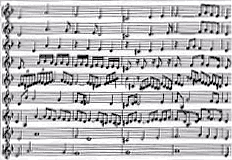 |
||
|
|
|
Celebrating the pipe organ, the King of Instruments |
The Art of Fugue
What is a Fugue? - Overview
THE PRINCIPAL THEME
What is counterpoint? The term comes from the Latin punctus contra punctum, meaning “note against note.” In counterpoint there are several individual voices or melodic lines that sound simultaneously, with each retaining its individual character and having equal weight in the composition. The fugue is a type of counterpoint built around a short theme (subject) that is stated at the beginning of the work and then imitated and developed by a secondary voice or voices (answer).
All 18 movements of Art of Fugue are based upon this simple theme in the key of D minor:

Bach takes this single theme and works it into increasingly elaborate variations - more than 20 different major variations and a hundred of minor ones. The following notation shows the principal theme (first line) and several variations (click to view a ![]() larger image):
larger image):

Graphic 1996, ![]() Timothy A. Smith, used by permission
Timothy A. Smith, used by permission
Bach uses a number of different techniques such as inversion, augmentation, and diminution, to vary the themes, and at the same time works these themes into increasingly complex fugal forms such as counter fugue, stretto fugue, double or triple fugue, or mirror fugue. These techniques and forms are best explored by looking directly at the Art of Fugue’s 18 movements, which are grouped according to the type:
a)
simple fugues (Contrapunctus I-IV)
b)stretto fugues (Contrapunctus V-VII)
c)double and triple fugues (Contrapunctus VIII-IX)
d)mirror fugues (Contrapunctus XII-XIII)
e)quadruple fugue (Contrapunctus XIV)
f)four canons


